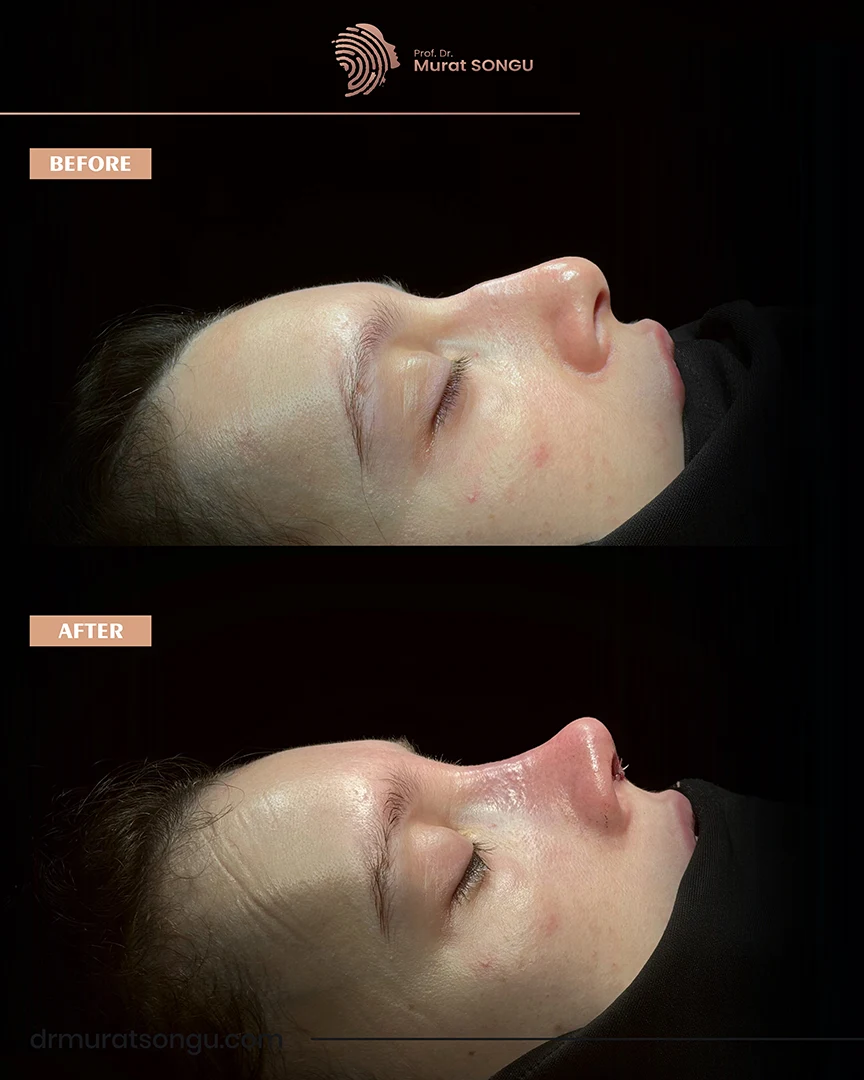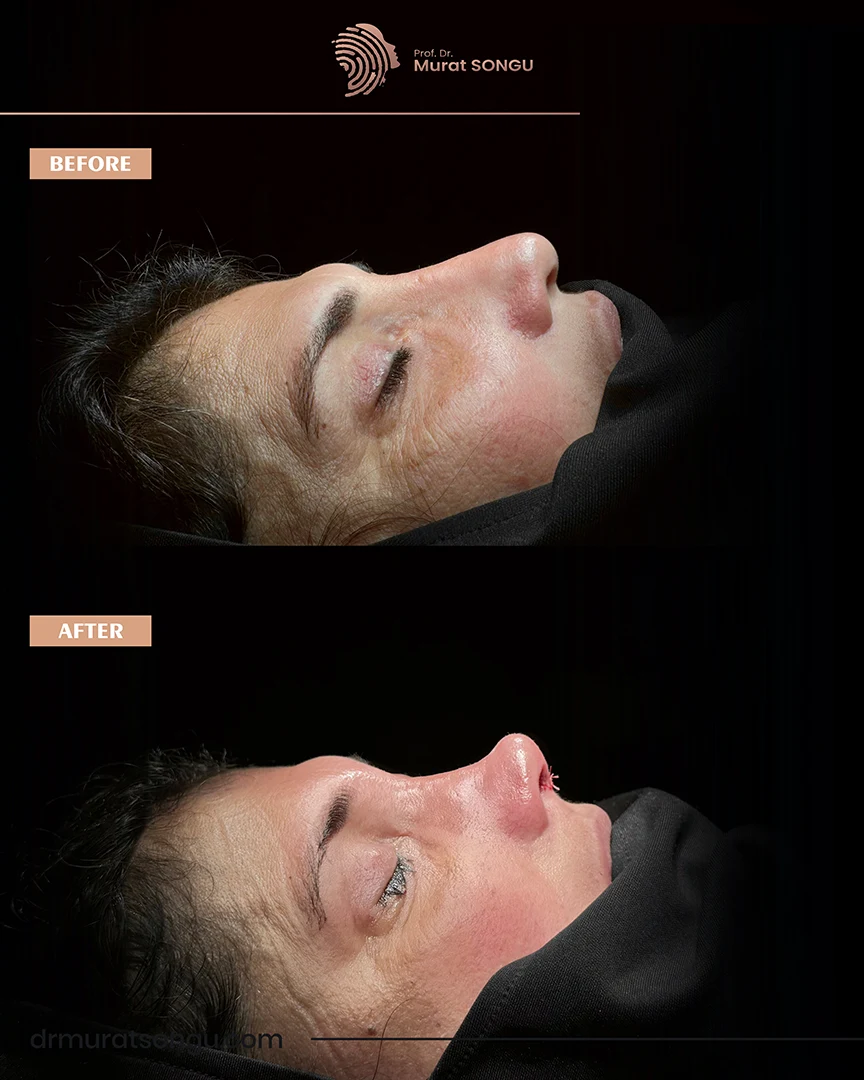Revision rhinoplasty is a complex surgical procedure aimed at addressing deformities and functional issues that may arise after a primary rhinoplasty. With its intricate anatomy and potential variations in healing, the nose presents unique challenges for surgeons. Thorough preoperative assessment and patient selection are crucial for achieving optimal outcomes.
This article provides a comprehensive guide to revision rhinoplasty, focusing on the evaluation of deformities, surgical planning, and the systematic approach to addressing specific nasal components. The goal is to provide a clear understanding of the surgical techniques and considerations involved in revision rhinoplasty for surgeons and patients alike.
Table of Content
One of the Best Surgeons for Revision Rhinoplasty in Turkey

Prof. Dr. Murat Songu is recognized as one of the top surgeons for revision rhinoplasty in Turkey, frequently sought out for correcting unsatisfactory results from previous surgeries. His extensive surgical experience and precision make him highly trusted in handling complex, secondary nasal corrections.
What Is Revision Rhinoplasty?
Revision rhinoplasty is a specialized surgical procedure performed to correct cosmetic and functional issues that persist or develop after a primary rhinoplasty. It involves addressing external deformities and breathing difficulties that may arise due to the intricate anatomy of the nose and the complexities of the healing process. This procedure requires the expertise of a skilled surgeon who has a deep understanding of the nasal structure and its dynamics.
The primary goal of revision rhinoplasty is to achieve improved nasal aesthetics and restore proper nasal function. Patient selection and thorough preoperative evaluation are crucial to determine the specific concerns and develop a tailored surgical plan. By employing advanced techniques and careful surgical maneuvers, revision rhinoplasty aims to provide patients with satisfactory outcomes and enhanced quality of life.
How Is Revision Rhinoplasty Performed?

Revision rhinoplasty is typically performed under general anesthesia and involves a meticulous approach to address the specific deformities or functional issues. The procedure begins with a thorough assessment of the osseocartilaginous framework of the nose, carefully evaluating each anatomical component. The surgical plan is then adjusted accordingly, and the nose is deconstructed to its individual units for a detailed examination.
Structural modifications are made systematically, starting from the upper third of the nose, addressing issues such as bony irregularities or incomplete osteotomies. The middle third is then addressed, correcting deformities like pollybeak, saddle nose, or inverted-V deformity, utilizing techniques such as grafting or spreader grafts. Finally, the lower third, including the nasal tip and alar region, is treated by reshaping the cartilages and addressing specific concerns like tip rotation or alar retraction. The procedure aims to restore proper form and function while ensuring long-term support for the nasal structures.
Recovery Process After Revision Rhinoplasty
The recovery process following revision rhinoplasty is an important phase in achieving successful outcomes. Patients can expect some swelling in the nose, which typically lasts for around 5-7 days. To aid in the healing process, absorbable sutures are used, eliminating the need for suture removal. Advanced techniques are employed by surgeons to minimize the need for nasal packing.
Patients are usually advised to wear a nasal splint for a period of time to support the newly reshaped nose and protect it during the initial healing stages. Pain medications may be prescribed to manage any discomfort, and proper wound care instructions are given to ensure proper healing. Regular follow-up appointments are scheduled to monitor progress and address any concerns during the recovery period.
Before & After Photos















































Is It Safe To Have Revision Rhinoplasty In Turkey?
The safety of having revision rhinoplasty in Turkey depends on several factors. Turkey has become a popular destination for medical tourism, offering advanced facilities and experienced surgeons specializing in rhinoplasty. Many clinics and hospitals in Turkey maintain high standards of patient care and safety. However, it is crucial to thoroughly research and select a reputable and accredited medical facility for the procedure.
Careful consideration should be given to the surgeon’s qualifications, experience, and expertise in revision rhinoplasty. Prioritize facilities that prioritize patient safety, adhere to strict hygiene protocols, and have a track record of successful outcomes. Additionally, ensure that there is open communication and a clear understanding of the procedure, risks, and post-operative care. Overall, with proper research and due diligence, it is possible to have a safe revision rhinoplasty in Turkey.
Why Is Revision Rhinoplasty Cheap In Turkey?
The affordability of revision rhinoplasty in Turkey can be attributed to several factors. Firstly, the lower cost of living in Turkey compared to many other countries allows for reduced overhead expenses, including clinic fees and staff salaries. Additionally, the competition within the Turkish healthcare market contributes to competitive pricing. Turkey has a well-established medical tourism industry, attracting a high number of international patients seeking affordable healthcare solutions.
This influx of patients provides economies of scale, allowing clinics to offer revision rhinoplasty at lower prices. However, it is important for individuals considering revision rhinoplasty in Turkey to thoroughly research and select reputable clinics and experienced surgeons to ensure the highest quality of care and safety standards are maintained.
How Much Does Revision Rhinoplasty in Turkey Cost in Turkey ?
Cost of revision rhinoplasty surgery in Turkey costs €8000 , it would be approximately $8,500 USD ( all-inclusive-package).
| Country | Average Cost of Revision Rhinoplasty Surgery (USD) |
| United States | $35,000 – $60,000 |
| United Kingdom | $30,000 – $36,000 |
| Canada | $18,000 – $32,000 |
| Australia | $24,000- $36,000 |
| New Zealand | $24,000- $36,000 |
| Ireland | $24,000 – $32,000 |
| Turkey | $7,000 – $9,000 |
What Affect the Cost of Revision Rhinoplasty?
The revision rhinoplasty also often costs more than the original procedure. One of the biggest contributing reasons is the expertise of the surgeon. A specialist in this area usually commands higher fees due to his ability to handle daunting challenges presented by previously altered structures of the nose. Another factor that will influence the price to a large extent is the complexity of the procedure. Prices will be varying with the scale of necessary adjustments:
- Minor modifications can be the cost-saving option if required.
Major revisions, such as cartilage grafting or revisions for breathing problems, are charged at an additional cost. Furthermore, the site at which the surgery is conducted is of great importance. This implies that the execution of the process in big towns, which normally have a very high cost of living, increases the total cost more than it would be in the rural centers. Lastly, the time the procedure takes impacts the cost of anesthesia and facility use. Since revision rhinoplasties often take longer than primary rhinoplasties, in this aspect, the associated fees may be increased. Each of these must be taken into consideration while planning the financial aspects of undergoing a revision rhinoplasty.
Revision Rhinoplasty Reviews
Frequently Asked Questions
The recovery process for revision rhinoplasty is longer compared to initial rhinoplasty surgeries. Generally, this process takes several weeks. Bruising and swelling may occur within the first week, which quickly subside. Recovery takes time due to the anatomical structure of the nose being affected by previous operations. Additionally, the cartilage used in reconstruction needs to adapt to its new position, slowing the process. By the end of the first month, the shape of the nose starts to become more defined. By the third month, the nose attains a more refined appearance. Full recovery usually takes between 12 and 24 months.
The nasal tip may drop after revision rhinoplasty. Generally, this depends on the amount of tissue removed during surgery. Removing too much tissue can lead to a loss of support for the nasal tip. On the other hand, the surgeon’s experience and the nature of the operation are also important. If the surgeon properly analyzes the nasal structure and applies appropriate techniques, the risk of drooping decreases. However, the natural characteristics of the nose always play a role. Therefore, individual differences in outcomes are to be expected. In conclusion, there is a risk of the nasal tip dropping after revision rhinoplasty, but this depends entirely on the surgery and individual anatomy.
A certain period must be waited after the initial surgery before performing revision rhinoplasty. Generally, it is recommended to wait at least 6 months after the first surgical procedure. Ideally, it is important to wait for this period to allow the tissues to heal and the nasal structure to fully reveal itself. During this time, the tissues regain their original softness and healthy structure. Additionally, necessary transformations in the tissues are completed within this period. Therefore, to achieve better results, it is advised to wait at least 6 months for the revision surgery.
Revision rhinoplasty is usually performed under general anesthesia. With this method, the patient loses consciousness and feels no pain. This allows the surgeon to perform the operation more carefully and in detail. However, in some special cases, local anesthesia or sedation may also be preferred. With local anesthesia, only the nasal area is numbed. Under sedation, the patient is in a light sleep state but remains conscious. The choice of anesthesia is made based on the patient’s health condition, the complexity of the operation, and personal preferences. It is the surgeon’s responsibility to determine the most suitable anesthesia method for each patient.
There is a possibility of permanent scars after revision rhinoplasty. Especially when using the open technique, scars may be visible on the nasal tip. In operations performed with the closed technique, the scars are less noticeable. The patient’s skin type is also an important factor; the risk of scarring is higher in thick and oily skin. Additionally, the individual’s wound healing capacity can affect the visibility of scars. Choosing an experienced surgeon is crucial to minimize these scars. It is necessary to follow post-surgical recommendations and carefully manage wound care.
Resting is very important after revision rhinoplasty surgery. In the first 24-48 hours, medications recommended by the doctor will minimize pain and swelling. Afterward, it is generally possible to return to daily routines within 1-2 weeks. However, the nose needs about 6-12 months to fully heal. During this period, it is crucial to avoid strenuous activities, prevent any impact to the nose, protect from the sun, and avoid smoking.
Revision rhinoplasty carries more challenging risks compared to the primary operation. Bleeding is a significant concern for patients. Additionally, the risk of infection poses a direct threat to health. Problems with wound healing can prolong the recovery process. Furthermore, the nasal shape not achieving the expected aesthetic results is a common issue. Breathing problems can negatively affect the quality of life. Finally, anesthesia-related risks remain present, as in any surgical intervention. It is essential to discuss these risks in detail with the doctor.
Awards




















